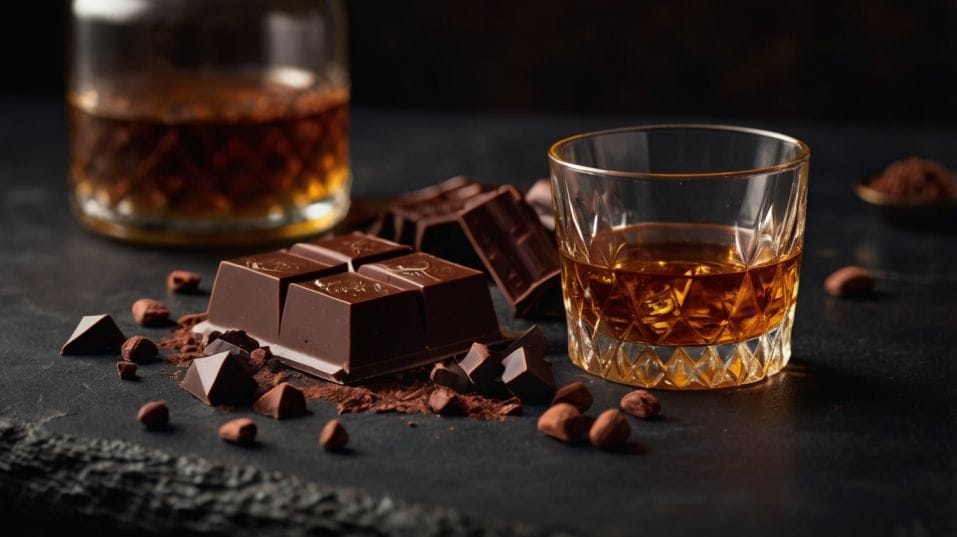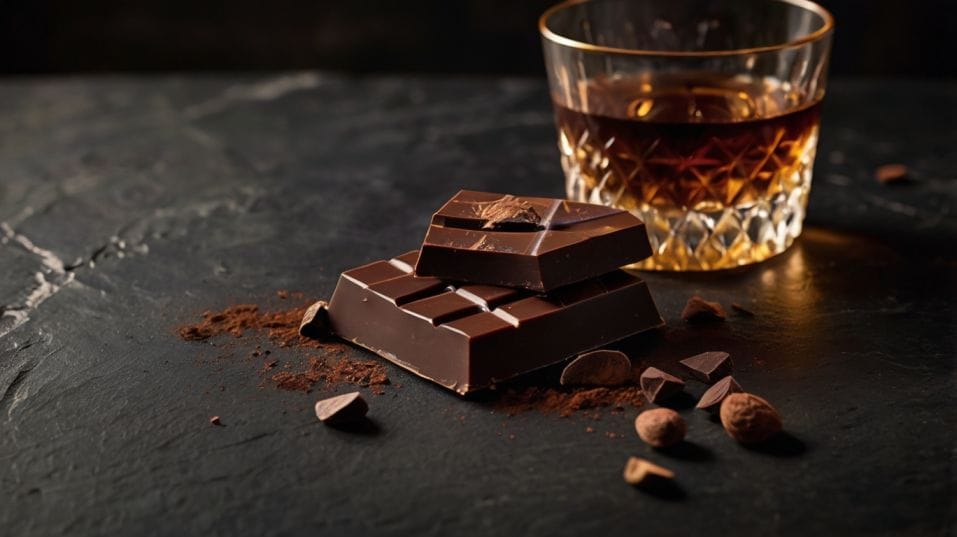Whiskey and Dark Chocolate: Try This Combo Tonight
Want to taste whiskey better, faster? Learn how pairing with dark chocolate sharpens your palate and builds real collector instincts.

What if the fastest way to understand whiskey isn’t in the glass—but on your tongue, next to a square of dark chocolate?
If you're just getting into whiskey, this one shift can change how you taste. Not to look sophisticated. Not for dessert. But to sharpen your palate.
The right chocolate adds friction, depth, and clarity—things a neat pour alone can’t teach. No gimmicks. Just flavor training that hits harder, faster.
Understanding the Mechanics: Why Chocolate Sharpens Your Palate
Whiskey has range. It spans fire and fruit, spice and sweetness, fat and finesse. So does dark chocolate. But together, something deeper happens: contrast, clarity, and tension.
You're no longer tasting whiskey in a vacuum. You’re testing its structure against another substance that has its own mouthfeel, its own bitterness, its own story of fermentation and heat.
Cocoa butter coats the palate, changes how alcohol lands. Tannins in the chocolate pull different flavors forward—like how water opens up whiskey, but more tactile.
The bitterness rewires your sense of sweetness. Suddenly, vanilla isn’t just vanilla. It’s toasted or raw or syrupy. Oak feels heavier. Heat lingers longer. Or shorter. You start noticing.
This is how professionals taste—by comparison, by friction, by force. Not by memorizing notes from the back of the bottle.

Choosing Chocolate Like a Taster, Not a Tourist
Don't walk into this like you’re picking dessert. You're building a tool. Look for chocolate with high cacao content—70% and up. No milk, no caramel swirls, no candy filler.
Read the label. You want minimal ingredients: cocoa mass, cocoa butter, maybe a touch of cane sugar. No soy lecithin if you can avoid it. That texture, that clean snap—that’s what gives you contrast when whiskey hits.
Why Origin Matters (and When It Doesn’t)
Single-origin chocolate helps if you want to explore terroir. Bars from Madagascar tend to be bright and red-fruited. Venezuelan chocolate leans nutty.
Ecuadorian? Earthy and floral. But honestly, origin isn’t the priority at first. Start with structure. Get a feel for bitterness, melt rate, fat content. The better you can read chocolate, the better you’ll read whiskey.
How to Pair: Not for Harmony, but for Friction
Forget the wine world’s obsession with matching notes. Whiskey pairing isn’t about echoing flavors. It’s about tension. Good pairings feel like a slow collision. That’s where the insight comes from.
A high-proof bourbon with a bitter, dry chocolate bar? Expect sparks. That alcohol heat softens when the cocoa butter coats your tongue. The whiskey’s sweetness punches through.
Suddenly you notice tobacco, cinnamon, even citrus you missed before. Then try the same bourbon with a softer, fruitier chocolate—it might flatten out, go quiet. Same whiskey. Different read.
Training Through Contrast, Not Compliment
That’s what you’re here for. Not perfection. Not harmony. Perspective. Try a sherried Scotch with a dark chocolate that leans into dried fruits. A peated malt with a salty chocolate laced with nibs.
A young rye with a spicy bar that doesn’t melt too fast. You’re not trying to impress anyone—you’re chasing reactions.
Each one tells you something about texture, finish, flavor layering, and how the brain processes contrast. That’s tasting with intent. That’s how collectors, makers, and tasters sharpen their instincts.
No Ceremony, No Gimmicks: How to Actually Do It
You don’t need a tasting board. You don’t need candles, jazz, or a curated flight. This isn’t an “event.”
It’s a tool you should be reaching for whenever you want to know a whiskey more intimately. Set the bottle out. Break a piece of chocolate. Take your time.
Let the chocolate sit on your tongue. Feel it melt. Don’t chew. Then sip the whiskey. Don’t chase it—let it mix. Let the heat hit differently. Swirl it around. Breathe through it.
Experiment with Sequence and Feel
Now reverse it. Sip first. Then taste the chocolate. See how the bitterness lands now. See what flavors stay behind and what gets erased.
Keep your water nearby, but don’t overuse it. Let your palate recalibrate naturally. The tension between sips is where your palate learns.
This is where tasting becomes skill-building. Not because you memorized anything—but because you paid attention to contrast, sensation, change.
The Hidden Benefit: It Makes You a Smarter Collector
If you’re building a shelf, not just draining bottles, this method gives you an edge. You start to understand how whiskeys behave in context. Which ones collapse under pressure. Which ones evolve. You learn to chase structure—not marketing.
You’ll find that some expensive bottles fall apart when put up against the right chocolate. Others, surprisingly humble, will hold their own.
That kind of insight is gold. It stops you from buying based on hype or packaging. It turns tasting into evaluation. You’re not just collecting. You’re curating.
Final Thoughts
Whiskey and dark chocolate isn’t a gimmick. It’s a shortcut to clarity. It teaches you to taste better, faster.
It turns your palate from a casual observer into a sharp instrument. You stop sipping blindly. You start decoding texture, finish, and structure.
So tonight, make it count. Pick one whiskey you like. Pick one dark chocolate bar. Taste them slowly, purposefully.
Don’t worry about getting it “right.” You’re building skill, not seeking perfection. Do it again next week. Try a different whiskey. A different bar. Build the habit.
Train your tongue. Trust your instincts. Build a collection you actually understand—one pairing at a time.




